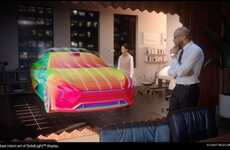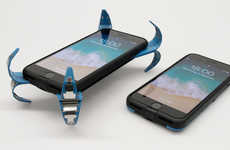
Human Media Lab Devises New Computing Interfaces for Unique Uses
Riley von Niessen — May 23, 2018 — Social Good
References: hml.queensu
Queen's University's Human Media Lab is a multidisciplinary media laboratory that creates different interfaces that facilitate further innovation in technology. So far, this has included Attentive User Interfaces, foldable paper computers, flexible smartphones and tablets, as well as pseudo holographic 3D cylindrical telepresence displays. Most recently, Human Media Lab has been working to design Organic User Interfaces.
To find out more about the groundbreaking work Human Media Lab has been busy with, Trend Hunter spoke with electrical engineering master's student Calvin Rubens. As he explains, Human Media Lab's aim is to uncover new ways of computing that go beyond the standard mouse and keyboard, which he says will one day be obsolete. With this, Human Media Labs enters the foray of programmable matter, which can take almost any form so that the interface can conform to the user, rather than the other way around.
To find out more about the groundbreaking work Human Media Lab has been busy with, Trend Hunter spoke with electrical engineering master's student Calvin Rubens. As he explains, Human Media Lab's aim is to uncover new ways of computing that go beyond the standard mouse and keyboard, which he says will one day be obsolete. With this, Human Media Labs enters the foray of programmable matter, which can take almost any form so that the interface can conform to the user, rather than the other way around.
Trend Themes
1. Attentive User Interfaces - Opportunity for developing interfaces that can respond and adapt to user attention and actions.
2. Foldable Paper Computers - Opportunity for creating flexible and portable computing devices using foldable paper materials.
3. Organic User Interfaces - Opportunity for designing interfaces that can conform to the user and offer a more intuitive computing experience.
Industry Implications
1. Technology - Disruptive innovation opportunities in creating new computing interfaces and devices.
2. Electronics - Opportunity for developing flexible and foldable electronic components for innovative devices.
3. Research and Development - Opportunity for further exploration and advancement in the field of human-computer interaction and user interface design.
1.8
Score
Popularity
Activity
Freshness















